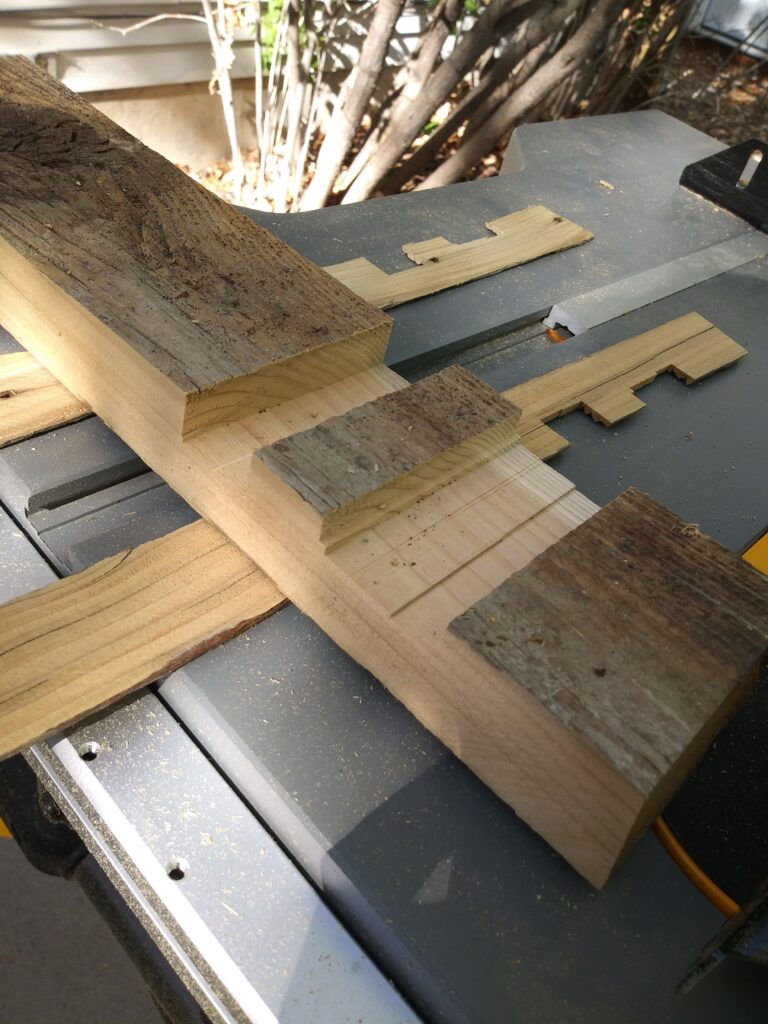I’ve been building up a collection of power tools over the years as my various projects require (okay, some projects are just an excuse to get a better tool than the one I have). One tool I’ve never gotten around to, however, is a table saw, partly because they’re expensive, partly because I’ve been able to make do with my mitre saw and circular saw, and partly because table saws scare me (I once took a 2×4 to the gut from kickback and feared I’d sustained internal injuries for a while).
I’ve started getting into more sophisticated projects lately, however, and I can’t always just trot down to my neighbor’s house to have him rip a few boards for me. He doesn’t mind, but so far all I’ve ever asked for is a couple of quick, simple cuts. That’s about to change. I decided it was time to start looking at what options there are for getting my own table saw.
My research turned up some simple details. There are basically two types of table saws: shop saws and jobsite saws. Shop saws usually come built into their own heavy-duty pedestal, have top-of-the-line motors and drives, and are built for precision. They often will cost $1000 or more, plus additional accessories, also built for precision.
Jobsite saws are smaller, more portable, potentially less powerful, and not really intended for precision work. They’re meant for more “bulk work,” like cutting sheets of plywood or particle board and rough cuts like would be needed on a construction job site (go figure!). They’re probably not the go-to saw for people building quality furniture, for example. You can pick up a decent jobsite saw for around $300 on up.
This was all interesting information, but did nothing to make my decision any easier. I decided to talk to my older brother, who is a long-time woodworker and owns the table saw that attempted the splenectomy-by-2×4 (he taught me properly, I just failed to fully comply). To my surprise he admitted he was thinking of getting rid of his expensive shop saw and was considering a jobsite saw instead.
He then proceeded to tell me which one he was considering–the exact some one I was currently favoring! You don’t know how bizarre it felt to be on the same page as my brother on anything concerning woodworking.
I still don’t consider myself an expert, but here are some of the things I considered in my search for the optimal saw:
Use Case – I’m a business analyst, so I’m used to a certain lingo. Use case simply means “how do you plan to use it?” Do you have a shop or a work area that is convenient to your projects? If you do all your work in a shop, you might want to consider a shop saw (wow, pretty radical, right?!). Those will be best suited to precision work and will be equipped to work with typical shop systems like dust collectors. If you do a lot of work at some distance from your house or shop, like building sheds or fences, portability may be the most important consideration.
Capacity – This is usually only a consideration when a fence (a rail along one side of the saw that guides the wood parallel to the blade) is involved. If you have no fence, there’s essentially no limit to how side a piece of wood you can cut, assuming you can control it. Fences allow for better control and closer measurement, but unless you remove them, they limit the width of the wood that can pass through. If you cut a lot of 4’x8′ sheets of plywood, for example, you’ll need at least a 24″ rip capacity to be able to cut one exactly in half.
Precision – If intricate cuts and joins and tight tolerances are important to your work, you’ll want a good shop saw with tight control over things such as blade depth and angle, fence adjustment, leveling, etc. You’re more likely to find what you need in a shop saw. Jobsite saws are more intended for quick-n-dirty, “good-enough” work. Most often their controls are going to be more “eyeball it and hope the locking mechanism doesn’t shift.”
Power – This gets a little fuzzier from my experience. Is it horsepower, voltage, amperage, or RPMs you most want? From my surveys of Amazon and similar sites, it’s anyone’s guess. But you’re more likely to get more control from a shop saw, like variable speed. Evidently RPMs matter when cutting certain types of materials, and the ability to adjust from 2000 to 4000 RPM, for example, may make a difference. Also, I would assume that higher horsepower is better for cutting harder woods. And then there are the vagaries of “worm-drives” versus…whatever other types there are. I didn’t get that far into it. But if you’re a serious woodworker you’re probably not going to want to listen to my input here anyway. I’m a layman looking for a tool that will give me basic, all-around performance.
Construction – A lot of jobsite saws have plastic housings and surfaces. Again, if you’re not looking for precision, that’s probably okay. I would imagine, however, that in time a plastic top is going to get scratched up, and that could impact how smoothly the wood moves through the blade. Shop saws are usually steel, built to take abuse, and still function with precision. But boy are they heavy and hard to move! (I’ve helped my brother move his.) On the other hand, a jobsite saw isn’t exactly light, and only some of them come with carts to help move them.
Dado Capability – This may not be all that important to everyone. A dado is a groove or a trench cut into a board. These can be made using a router, or you can use a table saw with what is called a dado stack, essentially a collection of blades and spacers that can cut a groove to a certain width. The maximum width of the dado of a given saw may make a difference. If, for example, its maximum width is 1/2″, it would be a waste to buy a 3/4″ dado blade set, as you’ll only ever use 2/3 of its capability. Wider is better, but mainly in efficiency. You could use the blade your saw comes with (if the kerf (thickness of the cut) is 1/8″ wide) and just make 8 narrow cuts side by side to get a 1″ dado. Or you can rip twice with a 1/2″ dado stack–a lot less work.
Other Considerations – Blade size may matter. The thicker the material you will likely cut, the wider the blade you’ll want your saw to be able to handle. A 10″ blade at best could never cut anything wider than 5″, and since the spindle (arbor) that the blade turns on generally can’t go higher than the underside of the table top, you’ll never be able to cut even half a blade’s width. I bought a saw with a 10″ blade, and can cut to a maximum depth of 3-1/8″ with the blade at a 90″ angle to the table, or only 2-1/4″ deep at a 45-degree angle.
The size of the worktop may be important, as well. There probably isn’t a standard size, so pay attention if you think it might matter to what projects you anticipate. You may also want to look at safety features, such as blade guards, anti-kickback devices, quick-stop blades, and the like.
The manufacturer may matter as well. I’ll admit I don’t have much wisdom to bestow here. There are some brands with good reputations, but whether the difference between them and their next closest competition is significant enough for the layman to notice, I don’t know. I’d recommend reading reviews, even though they can sometimes be more confusing than helpful. As for how to interpret reviews and star-ratings, I have my own strategy, but that’s another topic altogether.
So there you have it, the depth of my layman’s knowledge. I have since purchased my choice, and my review can be found here. I hope this is at least a little helpful.





